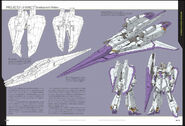The MSZ-006-3 Zeta Gundam "Strike Zeta" aka (MSZ-006 Zeta Gundam "Strike Zeta") is a mobile suit featured in the Masterpiece of Huge Arms design series.
Technology & Combat Characteristics[]
Developed by Anaheim Electronics for the Karaba Air Force during the first half of the Gryps Conflict, with financial support from Luio & Co. Ltd. (based in New Hong-Kong), The Strike Zeta is a redesigned version of the MSZ-006 Zeta Gundam exclusively for atmospheric use and in sub-orbital space flight. This variant featured a large flight sub-unit, fitted with a powerful built-in Hyper mega launcher and missile bays, and equipped with an anti-radar stealth effect, which was implemented within the flying armor as well. The Strike Zeta sports two grenade launchers and two thigh-mounted beam cannons, which are connected directly to its movable frame so that energy supply and fire control can be performed without using the mobile suit's hands. Unique to this unit are the thermonuclear ramjet engines, a system which used no combustion - a nuclear reactor heated the air instead (as opposed to the standard Zeta Gundam which ran thermonuclear jet/rocket engines), and the variable geometry wing transformation mechanism had been simplified from 3 to 2 steps, which proved ideal for inexperienced pilots. However, thanks to these modifications its cost-performance ratio and flight capabilities are dramatically increased.
Armaments[]
- 60mm Vulcan Gun
- 2-tube Grenade Launcher
- Thigh Beam Cannon
- FXA-01K-VW2 Flying Armor
History[]
Photographs of the Strike Zeta undergoing testing was included in a report to Anaheim Electronics stockholders, implying that at least one prototype unit was manufactured. However, whether or not the Strike Zeta was formally adopted by the Karaba Air Force is unknown.
Picture Gallery[]
Notes & Trivia[]
- The MS is modeled by Takayuki Komatsubara from studio-reckless, assisted by other studio-reckless members: Hiroshi Hayakawa, Makoto Komatsubara and Makoto Ishikawa, and was illustrated by Takayuki Yanase.








